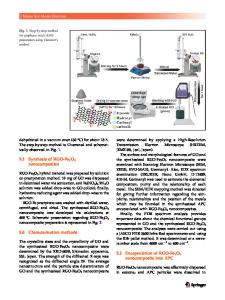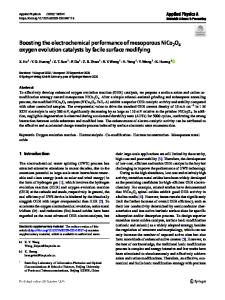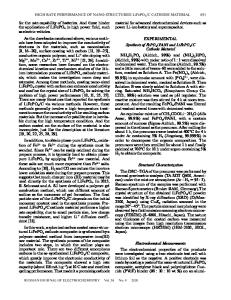Performance of Fe 2 P/LiFePO 4 /C Composites Synthesized by a Novel and Facile Method
- PDF / 1,363,753 Bytes
- 5 Pages / 612 x 792 pts (letter) Page_size
- 90 Downloads / 405 Views
HEMICAL KINETICS AND CATALYSIS
Performance of Fe2P/LiFePO4/C Composites Synthesized by a Novel and Facile Method Juan Wanga, Shuang Zhanga, Zhong-Bao Shaob, Hong-Qiang Ruc, Shu-Yan Zanga,*, and Hua Shena,** a
Shenyang University of Chemical Technology, Shenyang, 110142 China of Sciences, Northeastern University, Shenyang, 110004 China c School of Materials and Metallurgy, Northeastern University, Shenyang, 110004 China *e-mail: [email protected] **e-mail: [email protected] b School
Received December 29, 2019; revised April 15, 2020; accepted April 17, 2020
Abstract—A novel and facile one-pot method, named high-temperature high-energy mechanical force (HTHEMF), was successfully used to synthesize the Fe2P/LiFePO4/C composites. In this method, the combination of the high-energy mechanical force with the high-temperature not only simplified the synthesis process, but also reduced the temperature and time of the calcinations process. The temperature and time were 600°C and 10 h, respectively. X-ray diffraction analysis (XRD), scanning electron microscopy (SEM), high-resolution transmission electron microscopy (HRTEM) and electrochemical performance tests were employed to analyze the properties of the samples. The results suggested that Fe2P phase has a favorable effect on improving the electrochemical performance of the LiFePO4 material, such as high-rate capacity, low polarization phenomena and stable cycling performance. The composites delivered higher discharge capacities at different discharge rates, and it provided the first discharge capacities of 155 mA h g–1 about 7.6% more than which of the LiFePO4/C composites at 0.1 C. It indicated that the one-pot HTHEMF method is promising approaches to obtain the Fe2P/LiFePO4/C composites with good properties. Keywords: Fe2P/LiFePO4/C composites, cathode material, electrochemical performance, high-temperature high-energy mechanical force, one-pot synthesis DOI: 10.1134/S0036024420130300
INTRODUCTION Recently, due to the request of the clean and largescale rechargeable power sources for the development of the electric and hybrid vehicles, the application of lithium-ion batteries [1] has attracted widely attention. As a preferable cathode material of lithium-ion batteries, LiFePO4 composites with excellent properties have been synthesized through the considerable efforts of many researchers since the works by Padhi in 1997 [2]. However, the major limitations of LiFePO4 in the commercial application are the high cost of the raw materials and the inherent defects (low intrinsic electronic conductivity and slow lithium ion diffusivity [3]) which caused its low utilization of the total capacity. To reduce the cost, some previous works [4, 5] suggested to use the low-cost ferric compounds for the preparation of LiFePO4, such as FePO4 or Fe2O3. To enhance the rate capability of LiFePO4, numerous studies have been carried out, such as carbon-coating [6–9], ions doping [10–12], and particle size minimizing [13]. In usually, reducing the particle size by
mechanical force (bal
Data Loading...











